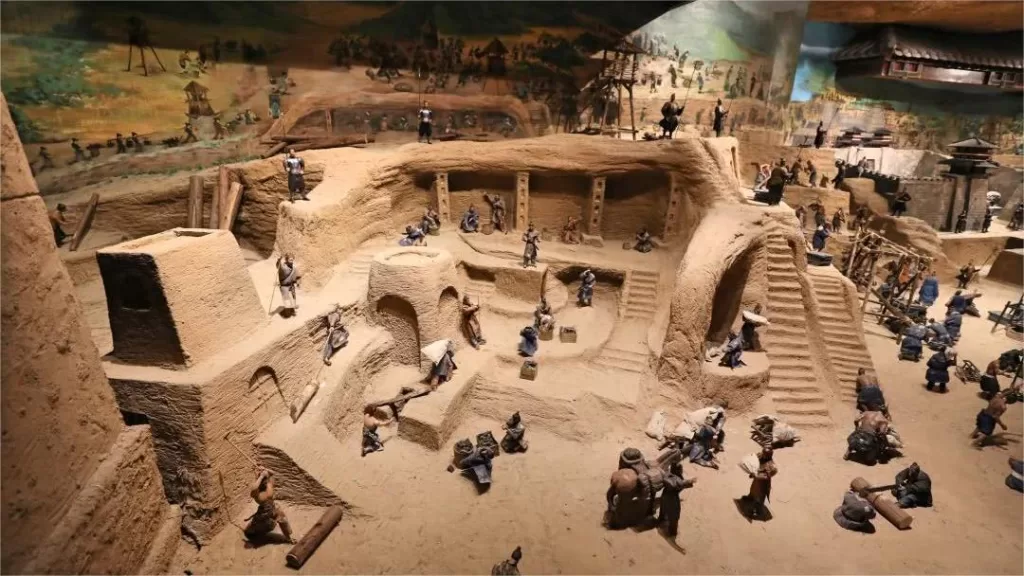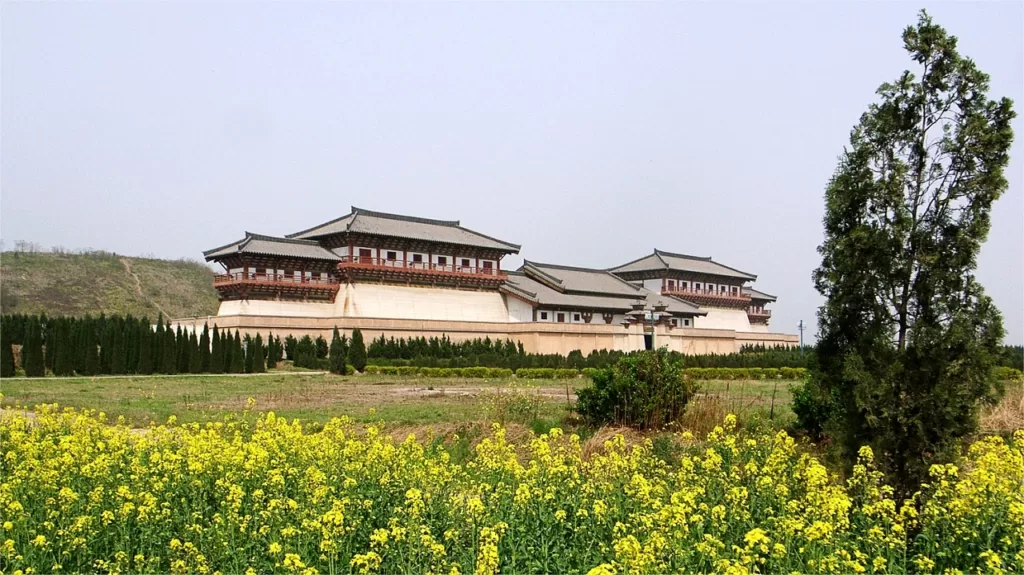Qianling Mausoleum (乾陵) is a historical site located in the Shaanxi province of China, near the city of Xi’an. It was built during the Tang Dynasty (618-907 CE) and is the final resting place of Emperor Gaozong (r. 649-683) and his empress, Wu Zetian (r. 690-705), the only female emperor in Chinese history.
The mausoleum is encircled by two sets of walls, with the inner city walls measuring 1450 meters from north to south, the east city walls spanning 1583 meters, and the west city walls extending 1438 meters. This vast complex covers nearly 2.4 million square meters, showcasing the grandeur and splendor of the Tang Dynasty.
The construction of Qianling Mausoleum began in the year 684 and underwent further expansion in 706. The mausoleum’s layout closely mimics that of Chang’an, the capital city of the Tang Dynasty. Beyond the primary tomb, Qianling Mausoleum is home to seventeen smaller accompanying tombs, where other members of the royal family and distinguished officials were laid to rest. Among the eighteen Tang Dynasty mausoleums, Qianling stands out as the one with the best-preserved main tomb and the unique distinction of never having been looted.
Table of Contents
- Basic Information
- Location and Transportation
- Map of Qianling Mausoleum
- Highlights of Qianling Mausoleum
- Vlog about Qianling Mausoleum
- Useful Tips Summarized from Reviews
- Facts about Wu Zetian
- Other Mausoleums in Shaanxi
Basic Information
| Website | https://www.zhongguoqianling.com/ |
| Estimated Length of Tour | About 2 hours |
| Ticket Price | 80 RMB (1st December – 28th February the next year) 100 RMB (1st March – 30th November) |
| Shuttle Bus | 30 RMB |
| Opening Hours | 8.00 – 18.00; Last admission: 17.30 (1st March – 30th November) 8.30 – 17.30; Last admission: 17.00 (1st December – 28th February the next year) |
| Telephone Number | 0086-029-35510222 0086-029-35510353 |
Location and Transportation
The Qianling Mausoleum is located in the Qinling Mountains, approximately 80 kilometers northwest of Xi’an. The area around the mausoleum is characterized by rolling hills, lush forests, and serene lakes, making it an ideal location for a final resting place. To get there from Xi’an, you can choose the following ways:
Take tourist line 3 at the East Square of Xi’an Railway Station. It departs at 8.00 am every morning and returns at 3.00 pm. The one-way ticket costs 18 RMB.
Or you can take a coach at the Xi’an South Passenger Depot, which departs about every 20 minutes, and transfer to the bus or take a taxi after reaching Qian county.
Map of Qianling Mausoleum

Highlights of Qianling Mausoleum
Stone Sculptures and Carvings

At the eastern and western sides of the Zhuque Gate at Qianling Mausoleum, you’ll find two sets of stone statues known as the “Stone Figures.” These meticulously arranged stone statues pay their respects at the front of the mausoleum. The western side features 32 statues, while the eastern side has 29, totaling 61 statues. These statues represent officials from various minority ethnic groups within the Tang Dynasty and foreign princes and envoys who attended the burial of Emperor Gaozong. Empress Wu Zetian erected these statues to showcase the grandeur of the Tang Dynasty. Carved on the backs of these statues are details such as their nationality, official positions, and names.
The Central Tomb

During the construction of Qianling Mausoleum, the Tang Dynasty was at its zenith, with abundant resources at its disposal. As a result, the mausoleum boasts an impressive scale, featuring magnificent and luxurious architecture. Drawing inspiration from Emperor Taizong’s innovative “mountain as tomb” concept, the mausoleum harmoniously combines architectural and sculptural elements, nestled amidst the surrounding hills and mountains.
The layout of Qianling Mausoleum replicates the urban planning of Chang’an, comprising an imperial city, a palace city, and an outer city. The main north-south axis stretches over 4.9 kilometers, and within the city walls, one can find structures like halls of offerings, auxiliary buildings, corridors, pagodas, and the temple dedicated to Di Renjie, among many others.
The Memorial Hall

The memorial hall in the Qianling Mausoleum is a large structure located on the eastern side of the central courtyard. It was built to commemorate the lives and achievements of Emperor Gaozong and Empress Wu Zetian and features a large statue of the empress and several other important artifacts and decorations, including carvings, paintings, and calligraphy. The memorial hall is an essential part of the Qianling Mausoleum’s cultural significance and gives visitors a sense of the importance and influence of Emperor Gaozong and Empress Wu Zetian during the Tang Dynasty.
Inscribed Stone Tablets

One of the most renowned features of Qianling Mausoleum is the enigmatic “Inscribed Stone Tablet.” This monumental tablet, located to the east of the Zhuque Gate, is carved from a single massive stone block, measuring 7.53 meters in height, 2.1 meters in width, and 1.49 meters in thickness. With a total weight of 98.8 tons, it exudes a profound and solid aesthetic, appearing as a single, cohesive entity. Remarkably, the tablet lacks any inscriptions or markings, which has led to it being colloquially known as the “Nine-Dragon Tablet” due to the nine dragons intricately carved on its front.
The “Inscribed Stone Tablet of Saintly Deeds” (Shusheng Jibi), located on the western side of the Sema Dao, stands in direct contrast to the enigmatic “Inscribed Stone Tablet.” It was composed by the Empress Wu Zetian and inscribed by her son, Emperor Zhongzong of the Tang Dynasty, commemorating the virtues and accomplishments of Emperor Gaozong. This inscription serves as a precedent for the placement of tablets in front of imperial tombs to honor the emperor’s achievements.
The Underground Chambers

Qianling Mausoleum also contains seventeen accompanying tombs, five of which were excavated between 1960 and 1971. These tombs include the tomb of Princess Yongtai, Prince Zhanghuai, Prince Yide, the Chancellor Xue Yuanchao, and Duke of Yan Li Jinhang. Over 4,300 precious artifacts were unearthed from these tombs, including more than 100 colorful and intricate murals. These mural paintings depict scenes such as “Horse Polo,” “Envoys,” “Bird Watching and Cicada Catching,” “Hunting,” and “Processions.” These vivid depictions are not only invaluable for the study of Tang Dynasty art but also provide insights into Tang Dynasty architecture, clothing, customs, sports, court life, and foreign relations.
Vlog about Qianling Mausoleum
Useful Tips Summarized from Reviews
Explore the Tombs: Qianling Mausoleum features the tomb of a princess and two princes, all of which are accompanying tombs where visitors can descend into the underground palace and view the coffins.
Utilize Sightseeing Cars: The mausoleum area is vast, with four separate tomb areas that are quite dispersed. It’s recommended to purchase tickets for the sightseeing car, priced at 30 yuan per person, to save time and avoid excessive walking.
Choose the Entrance Wisely: If possible, enter through the east gate as the route is relatively flat. The south gate involves climbing over 500 steps.
Consider Horse Riding: While exploring Qianling Mausoleum, visitors can opt to ride horses uphill. Once reaching the Holy Tablet, individuals may encounter locals offering rides to the main peak for a fee of 50 yuan per person.
Avoid the Replica Underground Palace: Adjacent to the tomb of Princess Yongtai, there is a replica underground palace area. It’s strongly advised to avoid visiting this area as it lacks authenticity and is filled with poorly crafted clay sculptures.
Prioritize Main Attractions: If time and energy are limited, focus on visiting the main tomb and the tomb of Princess Yongtai (Qianling Museum). The underground palaces of the princess and princes are quite similar, so visiting one suffices. Additionally, the tomb of Princess Yongtai offers the opportunity to view exquisite cultural relics unearthed from the Qianling Mausoleum.










Experience of visiting Mausoleum of Emperor Qianlong 1. If you are not driving by yourself, make sure to buy the ferry ticket. It costs 30 yuan per person. 2. Three accompanying tombs (Prince Yide, Princess Yongkang, and Prince Zhanghuai) will lead you down into the tomb passage. The passage and tomb chamber are narrow and damp, where you can see the coffin. If you are like me and easily scared, be mentally prepared! 3. There are many exhibitions in the… Read more »